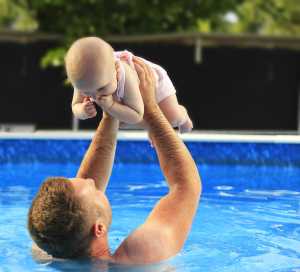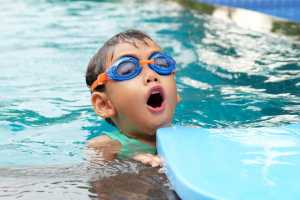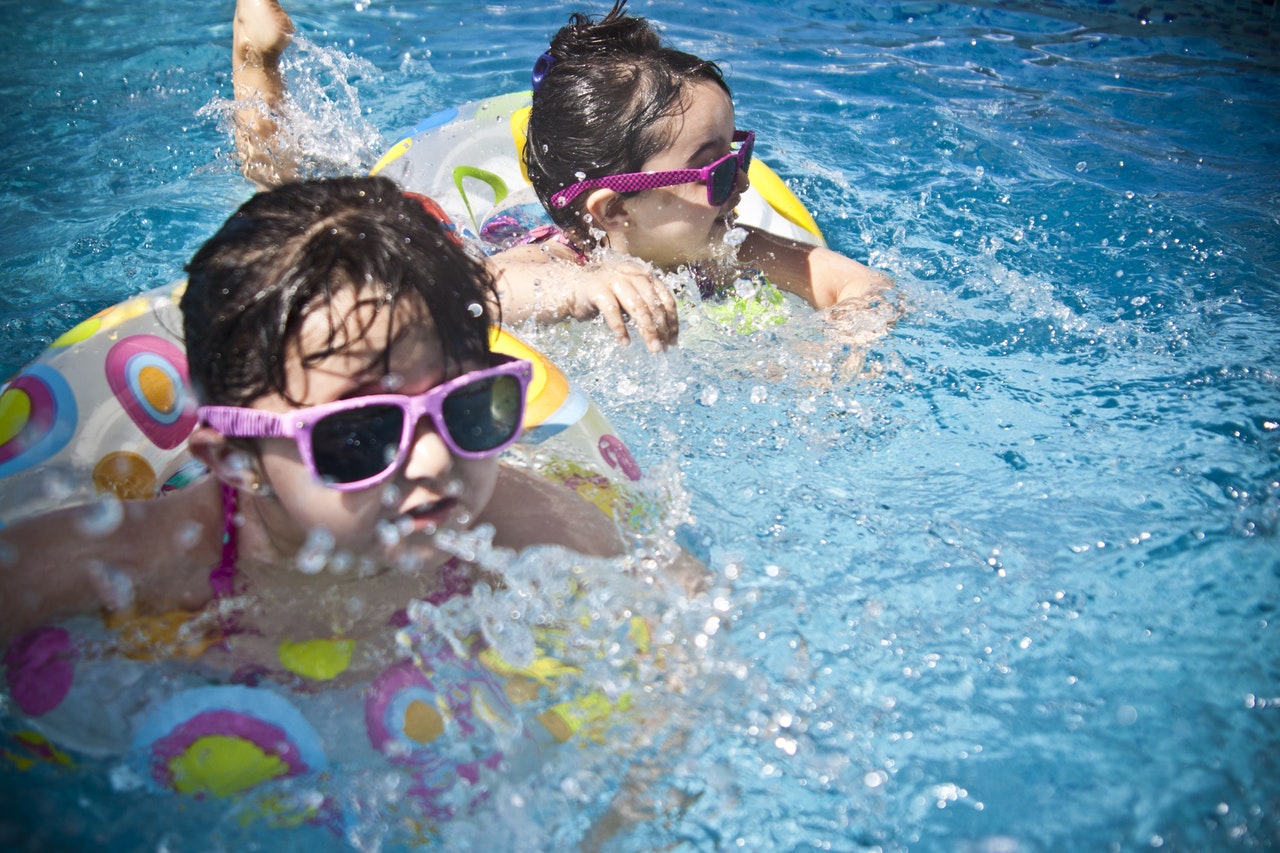Swimming is not just a recreational activity for your kids to partake in, but it’s an essential key skill for them to learn for their own safety. Having the ability to swim greatly increases their security in situations where bodies of water are involved, such as fishing, going to the beach, pool parties and just exploring the banks of a river.
It also means they can be included in these activities, especially when it comes to taking a dip in a pool to relax and cool down on a hot day or whilst on vacation. Swimming is also a fantastic exercise for weight maintenance and for staying in shape and much like learning a second language, it’s a skill that will be beneficial for the rest of their lives.
It’s perfectly normal for parents to send their kids to conventional swimming lessons, but some just can’t afford to, don’t have the time or want to supplement the lessons themselves. This is absolutely fine, just stick around and this article will give you what you need to know about teaching your kids to swim without swimming lessons.
How to Teach Kids How to Swim – 5 Simple Steps
When to Start Swimming Lessons
 When it comes to official swimming lessons, the American Academy of Paediatrics advises that “a child is not ready for formal swimming lessons until after their fourth birthday” due to them not being able to voluntarily hold their breath for extended periods of time.
When it comes to official swimming lessons, the American Academy of Paediatrics advises that “a child is not ready for formal swimming lessons until after their fourth birthday” due to them not being able to voluntarily hold their breath for extended periods of time.
This, of course, can make swimming lessons significantly more risky than for older kids.
It’s also been shown that the optimal age for children to learn how to perform front crawl swimming and that is at 5 years of age [Blanksby 1995].
The study reveals that once children to reach the age of 5, the number of lessons needed to teach how to do front crawl swimming is significantly less than for younger ages.
This does not mean at all that you should be afraid of your child to be in the water at a young age though. As in order to prepare them to learn to swim after they hit four years old, they need to be taught to “love the water” or at least not to fear it by preventing anxiety that can be caused by bad experiences.
Combatting the Fear of Water
It is generally thought that children are not born afraid of water that eventually builds up an anxiety that revolves around water based on unpleasant and sometimes traumatic experiences throughout their early lives [Stillwell 2011].
These unpleasant experiences may, to an adult, not seem to be so traumatic but to a child can cause stress; something as simple as accidentally being submerged in the bathtub, or being expectantly doused by water. But more frightening occurrences like falling into a river or being pulled into a swimming pool can make a lasting negative impression on them.
The child’s response to the events mentioned can very much depend on the adult’s reaction. This is where positive reinforcement comes into the equation. For example, if your baby or toddler was to accidentally get submerged in the bath, instead of panicking, pull them back upright, laugh with and applaud them for learning how to swim!
It’s important to continue this positive reinforcement when it comes to experiences with water that could be perceived as bad because when it comes to swimming and learning to swim, even if you’re swimming on the surface, water will continuously lap over your face and it’s something to expect and get used to.
A great way to teach your child to not fear the water is to experience it with them. If you’re at a pool party and they get splashed, laugh with them and let them splash you.
If you take them to a pool, ensure that you are in the water with them making the activity a fun bonding experience between you and them and other trusted friends and family.
Making Playtime with Water
Further to combat the fear of water, as you continue to ensure they don’t develop any anxieties associated with it, why not make it a fun activity as well?
Not only will it be easier for you to get them excited for bath time, but making bath time a fun activity and even a time for learning is great for their self-esteem when it comes to swimming.
What’s even better is having outdoor fun, it doesn’t even have to be a party, with a shallow pool and some water-based toys like a water table for example. Over time you can even increase the amount of water that’s in the pool, to get them used to larger depths in larger bodies of water than the bathtub and to get them to associate water as being a fun activity.
This can even work for older kids who may not have had great experiences with water and might be a bit fearful. Don’t be afraid to start them out with baby steps before getting them into a pool where they will need to swim.
Controlling the Breath
 This is where having less anxiety about being in the water really plays its part, as learning to control the breath is related to teaching the kids to hold their breath so that they don’t accidentally inhale water as they are swimming. It’s also a vital lesson for them to later learn to swim underwater.
This is where having less anxiety about being in the water really plays its part, as learning to control the breath is related to teaching the kids to hold their breath so that they don’t accidentally inhale water as they are swimming. It’s also a vital lesson for them to later learn to swim underwater.
This exercise can be taught in very shallow water, so shallow in fact that they can sit down and their head will be still above the surface.
Tell them to take in a deep breath and then to hold their breath, you count for 2 seconds followed by exhalation. Do this several times working your way up to 10 seconds. Once they can hold their breath properly, repeat the same process but this time have them place their face into the water.
This will get them used to the fact that their face will be submerged at times when they are swimming, and they’ll learn to anticipate and control this when they begin doing so. This exercise should be done alongside the initial lessons for this very reason.
There’s also an exercise which is similar in which you tell them to take and hold in a breath and to have their face upright in the water, just so the surface is below the nose. Then they can blow bubbles on to the surface of the water. It’s a technique you can use if they don’t like their face being submerged all the way.
The Initial Lessons
Now when they’re used to the water, rid of their fears and anxieties and ready to start actually swimming it’s time to learn the techniques involved in swimming. Before you do this, it’s best to get some vital equipment ready: a swim noodle, some armbands, a pair of goggles are the most essential.
What’ll make it more fun is to get some balls that can be used in the pool, some larger floats, a swim fin and some toys of your choosing that are safe for the pool.
One of the first activities that take place in formal swimming lessons is to have the kids sit on the edge of the pool with their legs in the water, and they just kick for a while. Tell them they don’t have to worry about making big splashes but to just go for it.
This is to get them familiar with the resistance of the water for when they actually enter the pool and is actually a great exercise to start out every session with. Once this has been done for 2 minutes or so, it’s time to step into the pool.
As long as they have the noodle, they can rest on top of it and it’ll keep their upper body afloat and will allow them to move their legs under the water to stay afloat. When they first start out, they’ll really be needing to get used to controlling themselves in the water and keeping themselves upright.
They’ll begin making a splash when they start to learn to move forwards but with your guidance, time and persistence, they can keep their legs mostly in the water and still be able to propel themselves.
After some practice with kicking, you can start to take the noodle away and hold them up yourself or have them hold on to the side wall as they begin to incorporate their arms to keep themselves upright instead of relying on equipment for buoyancy.

Teaching Better Control in the Water
As they start to get used to the concept that they’re able to stay afloat and can move in the water with the movement of their arms and legs they’ll be much more comfortable with completely going without floating equipment.
At this point, if you haven’t started structuring your lessons, it’s best to start to keep it from going stale. Something along the lines of having the first 5-10 minutes being a warm up just to get used to being in the water again, followed by another 10 minutes of fun and games, then some lessons or refining swimming technique and then end on a couple more games.
A simple structure like this can make a world of difference in keeping them interested and motivated and ending on an enjoyable game. As stated earlier, ending the session in a good mood so that they won’t lose interest in the next lesson despite any frustration they may have had with their progress is a good idea.
Teaching them to doggie paddle is a good way to get them moving about the water if they haven’t yet got the endurance to do a front crawl. It takes up less energy, and it’s easier for them to do. As they get more adept at swimming they should practice the front crawl as it’s a more efficient swimming technique.
Further Information
You now know the basics of teaching your kids how to swim, from starting out in their early ages of just getting them familiar with water to actually get into the pool and moving through the water with your guidance.
It’s important to know that there are many swimming techniques that can be learned in formal lessons that do make swimming a lot more fun and engaging but you can also look up videos online which will bring up guides on certain techniques too.
There’s also other tips and pointers out there to make your lessons more engaging, refined and safe some of which are listed below:
Kids Swimming Lesson Tips and Safety
- Praise constantly.
- Always be in a positive mood and reward progress.
- Make the lessons a family activity or join with friends!
- Avoid other children who react badly to the water, kids are imitators.
- Teach them to love water but always ensure they know about safety around water.
- Supervision is paramount, never leave them unattended and always make sure you or another trusted adult can get to them at all times.
- Treat them to their favorite meal after the lessons to reward them.
- Most importantly – make it fun!
References
- [Stillwell 2011] Belinda E. Stillwell. Best Practices for Teaching Those Afraid in Water: David Publishing February 2011, Vol. 8, No. 2, 249-255.
- [Blanksby 1995] Blanksby BA, Parker HE, Bradley S, Ong V. Children’s readiness for learning front crawl swimming: Aust J Sci Med Sport. 1995 Jun;27(2):34-7